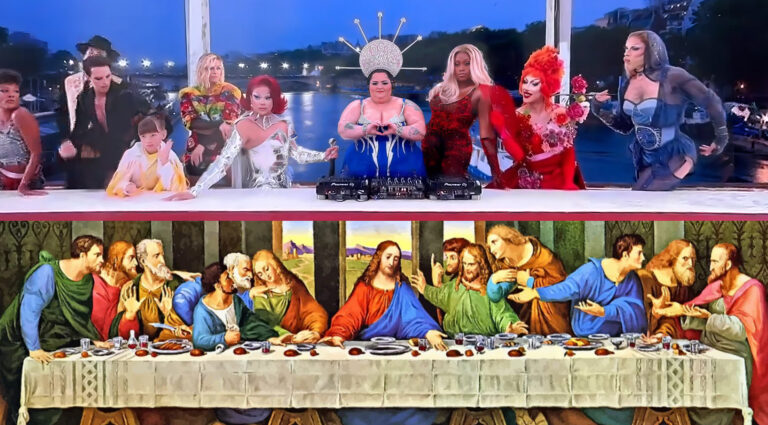The opening ceremony of the Paris Olympic Games brought with it a whirlwind of contention online. Religious leaders, politicians, and celebrities criticized the event and Christians argued both across and within the body. Some declared outrage at the flagrant debauchery while others cringed at the perceived ignorance and intolerance of their brothers and sisters in Christ.
So, what did we really see at one of the most televised events of the year and how should the Christian respond?
Last Supper or Pagan Feast?
Over the past week, there’s been numerous mixed reports regarding the Olympic opening ceremony that have created a fresh layer of murkiness for all. During the highly anticipated event, most viewers immediately recognized the artistic reference to Leonardo da Vinci’s famous painting, The Last Supper. However, as outrage poured out, and Olympic representatives backpedaled, many have argued that the scene was simply a feast celebrating the Greek god Dionysus.
Since then, the internet has been swarming with condescending rhetoric aimed at the thin-skinned, uneducated Christian who presumably can’t tell the difference between Italian art and Greco-Roman mythology. Poor, naïve little Christians.
The fallacy of this dispute is the belief that this is an either-or scenario. Meaning, the artists were either looking to present Da Vinci’s painting or they were enacting the feast of Dionysus. The fact is both can be true.
Halfway into the opening ceremony, viewers were shown a scene with undeniable similarities to Da Vinci’s famous painting. As one art historian put it, “The idea of the central figure with a halo and a group of followers on either side — it’s so typical of ‘The Last Supper’ iconography that to read it in any other way might be a little foolhardy.”
Forty-five minutes later, a blue Dionysus entered the scene on a large dish filled with flowers followed by a display of provocative song and dance.
Two scenes, two performances, one location.
Don’t Be Fooled
Though the Creative Director, Thomas Jolly, claims the scene had nothing to do with the iconic Renaissance painting, countless viewers across the globe recognized the undeniable similarities. Even the French media dubbed the scene, ‘La Cène sur la scène sur la Seine’ which is a play on words translated to ‘The Scene (French title for The Last Supper) on the stage on the Seine (river).’
Amid the backlash Jolly, explained to the Associate Press, “My wish isn’t to be subversive, nor to mock or to shock… Most of all, I wanted to send a message of love, a message of inclusion and not at all to divide.”
Call me skeptical, but when one chooses to place a halo above a scantily dressed LGBTQ+ activist seated at the center of a world-famous religious scene, one wonders if such claims can be taken seriously. Particularly when that activist, Barbara Butch, later shared an image of The Last Supper juxtaposed next to the Olympic ceremony scene. A post she captioned, “Oh yes! Oh yes! The New Gay Testament!”.
Jolly’s “intended” message of love and unity seems even less sincere when one considers the scenes featuring provocative dancing from crossdressers gyrating in the presence of a young girl.
Wedged Between Outrage and Passivity
In response, two extremes have emerged among the Christian community that one should be wary of joining. The first is fiery outrage. Of course, it’s natural for Christians to feel burdened by the world’s ongoing assault on things we hold dear. But the fiery outrage displayed by some appeared to indicate a, dare I say, lack of emotional and spiritual maturity.
Firstly, getting emotional makes it more challenging for others to take legitimate concerns seriously. Heated language can cause people to shut down and tends to weaken the point you hope to make. Why? Because rational, well-reasoned people don’t get emotional. They state their concerns calmly.
Secondly, it smells of insecurity. Christians who pull verses like Galatians 6:7 out of context and fiercely proclaim, “God will not be mocked!” seem utterly unprepared for the possibility that he can be. In fact, he was and will continue to be until Christ returns. But take heart! Nothing can be done now that will ever compare to the greatest moment of disdain and contempt thrown at our Lord and Saviour when he hung on the cross. And yet, he overcame both death and mockery. Rest easy fellow Christian, he always will.
At the other extreme were the self-identifying “cultured” Christians. The ones educated and informed enough to know that nothing offensive was really going on. It was all just a misunderstanding. These Christians cringed and shook their heads at their outraged brothers and sisters for being so ignorant of Greco-Roman art.
Just as I’d caution the offended Christian from jumping into heated outrage, to these believers I’d caution not to be so quick to dismiss what is in plain sight. Nobody wants to believe that their beliefs are being publicly subverted or ridiculed. However, evil no longer hides among us and it is foolish to pretend otherwise. It parades around clothed in attractive words like “tolerance”, “inclusivity”, and “justice,” while offering none.
A wise middle ground is offered to us in the words of Christ, “Behold, I am sending you out as sheep in the midst of wolves, so be wise as serpents and innocent as doves.” (Matt. 10:16)
Was Jesus Inclusive?
Some have pointed out the irony of the Church’s offense at an inclusivity-focused performance filled with individuals Christ would have presumably welcomed at his table. This is a common progressive revisionist understanding of Christ’s love.
While Christ invites all, he does not welcome all. The difference lies in a person’s willingness to repent and place their faith in him. For those who refuse, this is the unpopular message of the Gospel. For those who do, this is our everlasting hope.
When the culture mocks, do not be shaken. Christ has overcome.



